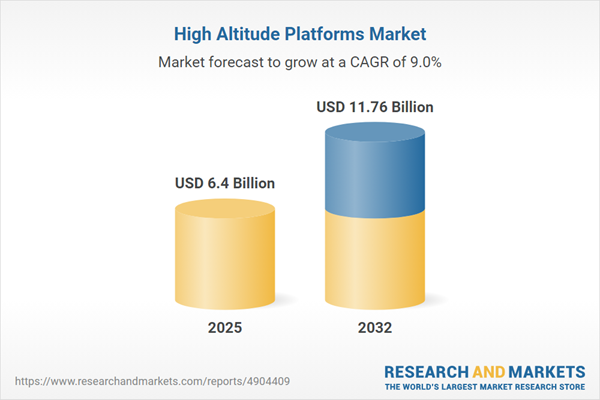Speak directly to the analyst to clarify any post sales queries you may have.
The high altitude platforms market is advancing rapidly, driven by the convergence of innovative technologies and evolving operational requirements, offering new pathways for connectivity, surveillance, and observation applications.
Market Snapshot: High Altitude Platforms Market Growth and Opportunity
The high altitude platforms market grew from USD 5.88 billion in 2024 to USD 6.40 billion in 2025 and is projected to maintain robust growth at a CAGR of 9.04%, reaching USD 11.76 billion by 2032. This sustained expansion reflects increasing global investment in stratospheric platforms capable of delivering critical services for telecommunications, defense, disaster response, and environmental monitoring.
Scope & Segmentation: Diverse Applications and Strategic Regional Analysis
This report delivers granular analysis across multiple dimensions. Key segmentations include:
- Product: Airships, balloons, unmanned aerial vehicles (UAVs), and related services supporting mission planning, analytics, and maintenance.
- Power Source: Battery-based systems (flow battery, fuel cell, lithium-ion), gas turbine platforms, hybrid power solutions (fuel cell plus battery, solar plus battery), and solar-powered systems (photovoltaic cells, solar thermal).
- Application: Defense and surveillance, disaster management, earth observation and remote sensing, environmental monitoring, telecom, and broadcasting.
- End User: Disaster response agencies, government organizations, research institutions, media companies, and telecom operators requiring customizable solutions for specialized mission objectives.
- Region: Americas (including the United States, Canada, Mexico, Brazil, Argentina, Chile, Colombia, Peru), Europe, Middle East & Africa (United Kingdom, Germany, France, Russia, Italy, Spain, Netherlands, Sweden, Poland, Switzerland; UAE, Saudi Arabia, Qatar, Turkey, Israel; South Africa, Nigeria, Egypt, Kenya), and Asia-Pacific (China, India, Japan, Australia, South Korea, Indonesia, Thailand, Malaysia, Singapore, Taiwan).
- Key Companies: AeroVironment, Inc., Airbus Defence and Space SAS, Thales Alenia Space, Lockheed Martin Corporation, The Boeing Company, Northrop Grumman Corporation, HAPSMobile Inc., Aerostar International, Inc., China Aerospace Science and Technology Corporation, BAE Systems plc.
Key Takeaways: Strategic Insights for Senior Decision-Makers
- High altitude platforms offer persistent, flexible coverage alternatives that directly address the limitations of satellites and ground networks, especially in remote and disaster-affected areas.
- Technological advances in lightweight materials, autonomous control, and hybrid power architectures are significantly enhancing the operational lifespan and cost-efficiency of these systems.
- Diverse use cases—from real-time environmental monitoring to resilient broadband delivery—are driving adoption among government, defense, telecom, and research sectors.
- Regulatory frameworks concerning airspace management and frequency allocations remain central; close collaboration between stakeholders and policymakers is essential to program success.
- Public-private partnerships and agile development cycles are accelerating commercialization, underscoring a shift toward ecosystem-driven solutions and modular service offerings.
Tariff Impact: Adapting to Evolving Supply Chain Realities
Recent United States tariff policies have increased costs of critical imported components, such as advanced composites and specialized batteries, compelling industry leaders to adapt sourcing strategies. Organizations are pivoting towards domestic manufacturing and expanded sourcing in low-tariff jurisdictions, enhancing supply chain resilience while managing immediate cost challenges. These adjustments are expected to drive long-term gains in efficiency, oversight, and supply continuity.
Methodology & Data Sources
This high altitude platforms market research leverages a blended methodology combining secondary research—reviewing peer-reviewed journals, technical white papers, and regulatory publications—alongside in-depth primary interviews with platform developers, end users, and regulatory experts. Findings are cross-verified using triangulation methods, and advanced analytical frameworks such as SWOT and PESTEL are applied for comprehensive market context and insight validation.
Why This Report Matters: Actionable Intelligence for Strategic Growth
- Supports informed capital allocation and partnership decisions through detailed market segmentation and regional insights.
- Enables proactive supply chain and risk management by covering regulatory, tariff, and sourcing trends.
- Equips senior decision-makers with actionable strategies to accelerate adoption, mitigate operational risks, and address evolving mission requirements in an innovation-driven ecosystem.
Conclusion
As industry shifts toward greater automation and hybrid energy architectures, the high altitude platforms market is positioned as a key enabler of next-generation connectivity, monitoring, and resilience. Stakeholders prepared to engage collaboratively and invest in adaptive technology are poised to capitalize on the sector’s evolving opportunities.
Additional Product Information:
- Purchase of this report includes 1 year online access with quarterly updates.
- This report can be updated on request. Please contact our Customer Experience team using the Ask a Question widget on our website.
Table of Contents
3. Executive Summary
4. Market Overview
7. Cumulative Impact of Artificial Intelligence 2025
Companies Mentioned
The companies profiled in this High Altitude Platforms market report include:- AeroVironment, Inc.
- Airbus Defence and Space SAS
- Thales Alenia Space
- Lockheed Martin Corporation
- The Boeing Company
- Northrop Grumman Corporation
- HAPSMobile Inc.
- Aerostar International, Inc.
- China Aerospace Science and Technology Corporation
- BAE Systems plc
Table Information
| Report Attribute | Details |
|---|---|
| No. of Pages | 195 |
| Published | November 2025 |
| Forecast Period | 2025 - 2032 |
| Estimated Market Value ( USD | $ 6.4 Billion |
| Forecasted Market Value ( USD | $ 11.76 Billion |
| Compound Annual Growth Rate | 9.0% |
| Regions Covered | Global |
| No. of Companies Mentioned | 11 |









